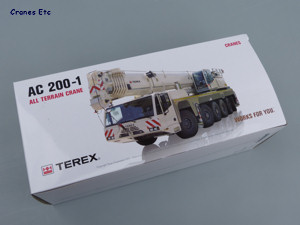 |
| Terex box. |
 |
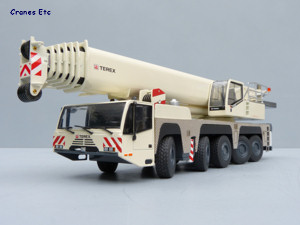 |
| On the road.
|
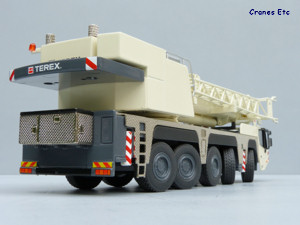 |
| One counterweight
is permanently attached. |
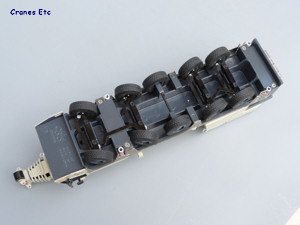 |
| No detailing underneath.
|
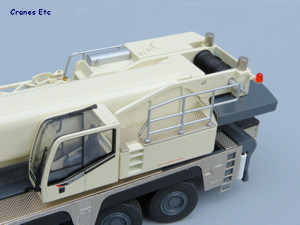 |
| Metal handrails.
|
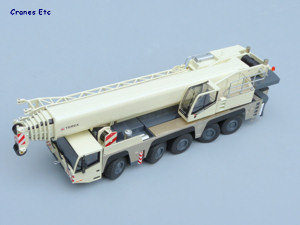 |
| Steering axles
turned. |
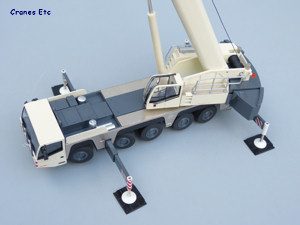 |
| The small baseplates
are not included. They are available separately as
NZG 7871. |
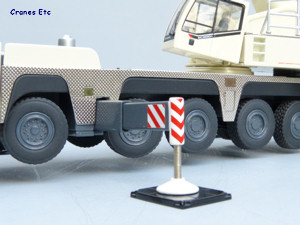 |
| Wheels off the
ground. |
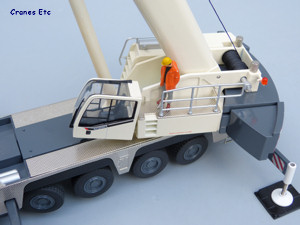 |
| Cab tilts a little. |
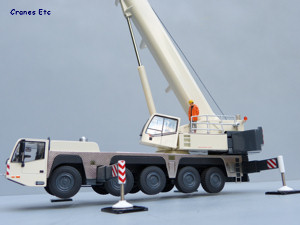 |
| Outriggers are
strong enough to lift the model. |
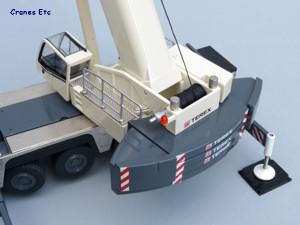 |
| The outrigger post
lacks chevrons on the review model. |
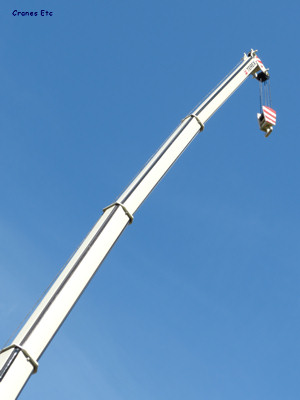 |
| Bend in the boom
is realistic if was lifting a load. |
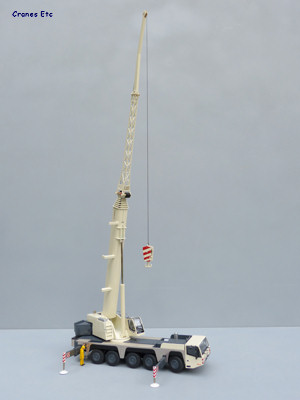 |
| Fly jib on. |
|
The AC 200-1 is a nominal 200t capacity
five axle crane (also available in six axle configuration
in some countries) originally from the Demag stable, and
now a staple of the Terex brand. For photos of the
real machine click
here.
The model was first introduced in 2003 as
NZG 514. In 2008
an updated version was introduced as
NZG 730. This further
updated version was introduced in 2012.
Packaging
The packaging for this model consists of a good quality
outer sleeve with a photo which shows the 6-axle variant
of the crane rather than the 5-axle version modelled.
Inside, there is a two piece polystyrene tray containing
the model. Inside, the model is carefully wrapped.
No instructions are provided but assembly of the few parts
is straightforward.
There were no missing parts on the review model although
one outrigger post lacked chevron markings. A replacement
part was obtained.
NZG also provide a pair of cotton gloves with the model
to prevent finger marks.
Detail
The underneath of the carrier is purely functional with
no detailing, The wheels have good tyres and the metal wheels
are good with a different hub design on the front axle.
The driving cab has windscreen wipers, mirrors, and the
headlights are painted on. The cab interior details
are simple, and there is a fine loop at the front of the
crane for attaching a hook during transport. A change
on this version of the model is that there are no beacon
lights on the cab roof.
Location points are provided on the carrier body for loading
the counterweights during erection, and there are textured
surfaces on the top surface and sides.
The crane body detail is also good with wipers on the cab
and very good metal handrail and stepping details.
The cab windows are better on this new version of the model
with realistic window seals.
The counterweight consists of three pieces. One is
intended to be permanently attached, and the other two make
up the full counterweight but the larger piece is not realistic
and is combined from several parts on the real crane.
The main boom is in seven sections. A folding fly
jib is provided and has well formed latticework. The pulleys
are metal and separate and this is the main change to the
previous version of the model. It is certainly an
improvement. The Terex name on the boom is much smaller
than on the previous version, in fact the graphics all round
are rather understated.
The metal hook block is very good and in keeping with the
size of the crane, however it is too large to be realistic
hanging from the fly jib.
Features
The front and rear pairs of axles steer. Each pair
is linked together and they steer well in tandem so most
of the steering modes of the real crane can be replicated.
The outriggers are very good. They each have two stage
metal outrigger beams which pull out and the metal pads
lower with a robust screw mechanism.
The crane cab can be tilted a little.
The main counterweight is attached to the crane body by
a pair of screws. When attached the overall effect
is good, and the crane can rotate fully without a problem.
However if the counterweight is removed and rested on the
carrier using the locating lugs then the crane body cannot
rotate as it is fouled by the counterweight. This
appears to be scaling problem and in reality is of little
practical consequence because it does not prevent the crane
being posed in almost every possible way. When in
transport mode the model still has one counterweight plate
permanently attached. A skilled collector can probably
remove it by undoing the hidden screws.
The boom cylinder has been drilled with a hole so that it
can be pinned when erect to prevent boom sag. Thoughtfully
the hole is in the plane of the boom so it is not visible
for most practical purposes. The boom is a seven section
telescope and extends well, although fully extended it needs
to be carefully set up to avoid sideways lean.
At the boom head the folding fly jib can be attached by
pins and this is straightforward to do. However the
jib has no intermediate pulleys so fully extended is the
only option. With the fly jib attached a big model
results and it stands nearly 1.7m tall.
The winch is operated using one of the tools NZG provide
for the purpose which works well. The hook rotates
from the block and this allows more flexibility in posing
lifts.
Quality
The paint finish is high quality as are the graphics, although
some graphics were missing from the review model.
It is a very heavy model reflecting the high metal content.
Price
It is very good value for a five axle crane.
Overall
This model has been around for a long time and shows its
age a little in terms of details and features. The
revisions on this version are small but worthwhile, and
it is a recommended crane model.
Footnotes
The model first appeared at the Nuremberg Toy Fair in 2003
as model number 514,
and was revised as model
730. A version of this revision was also produced
in the colours of Merkel.
|
|
|
|
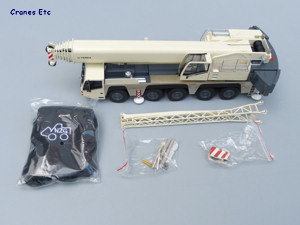 |
| The model inside
the box. |
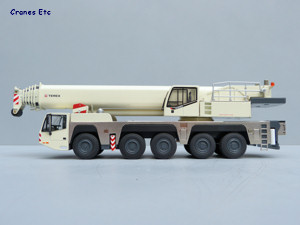 |
| Profile view. |
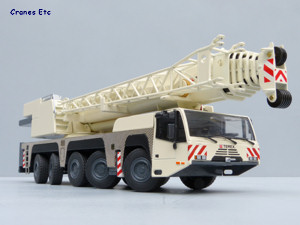 |
| It looks good.
|
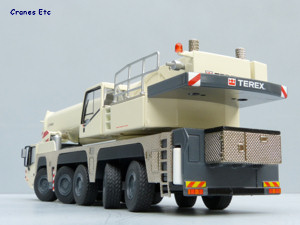 |
| Tool box at the
rear. |
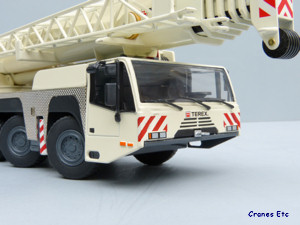 |
| Cab looks fine
- lights are painted. |
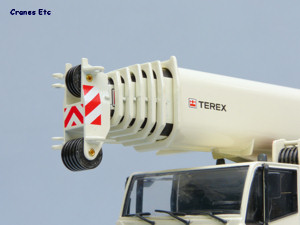 |
| Metal pulleys are
all separate. |
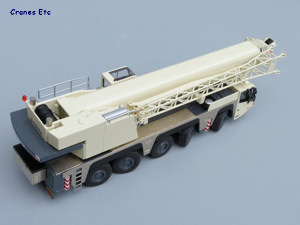 |
| Fly jib mounted
on the boom. |
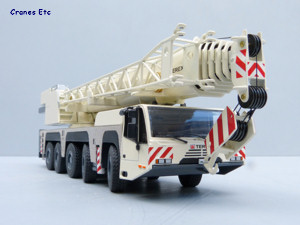 |
| You can tie the
hook on to the front but it is large. |
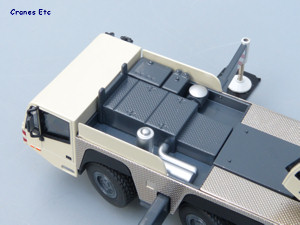 |
| Moderate detail
behind the cab, and no beacon lights on the Terex coloured
version. |
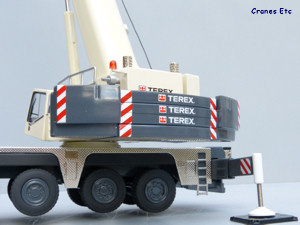 |
| Counterweight does
not split realistically. |
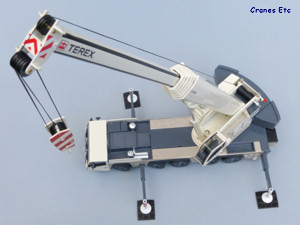 |
| Top boom section
is pretty thin because of the 7 piece telescope. |
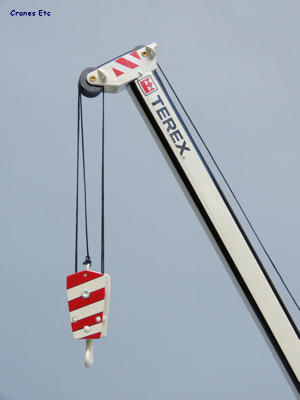 |
| Boom top detail. |
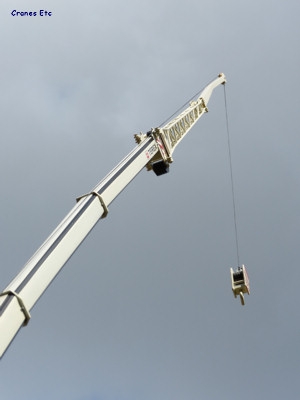 |
| The hook is too
large for the fly jib really. |
|

